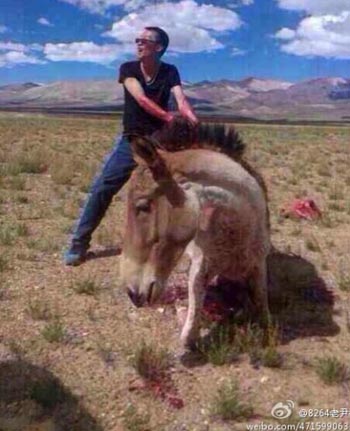A picture of a man, his hands covered in blood “while harvesting organs from a live Tibetan wild ass” circulated over the internet on Facebook, Twitter and Wiebo. Comments poured in condemning such “unforgivable sin” and called the man a “monster” and a “beast”. The man was later identified as Chen Haisheng, a Chinese tycoon engaged in railway engineering and real estate in Tibet – and said to be the only person in Lhasa who owns a Ferrari.
As the picture went viral on internet, the local forest police started their investigation and few days later arrested Chen Haisheng and his companion Li Ming. Xinhua, the Chinese state media, reported that the two suspects chased and hit the animal with a vehicle in the Ngari Jangthang National Nature Reserve. Chen killed the animal with a knife, and then disembowelled it. The two took the body to their workplace where they cooked it and shared it with fellow workers.
Although, after their arrests, Chen and Li confessed to the crime of killing an endangered animal of Tibet, it is not known what legal action has been taken against them. The Tibetan wild ass or Kiang (in Tibetan) is a first class national protected animal. According to China’s Wild Animal Protection Law implemented in 1989, a person who hunts or slaughters national protected animals can be imprisoned for up to five years.
Environmentalists say the Tibetan wild ass is not only endangered species killed in China: tiger penis, tiger bones, and rhino horns are still illegally traded and consumed with wine by the Chinese elite.
“In recent years, we have seen that tiger bones, rhino horns, and some other ingredients that were traditionally used in medicine are shifting to being used as collectables, as investments, and as gifts in business or politics,” Grace Ge Gabriel, Asia Regional Director of the International Fund for Animan Welfare told Voice of America in a telephone interview.
Much of the Kiang’s habitat has been degraded or lost due to mining and oil exploration operations. The Kiang population has decreased significantly over the last few decades, and become fragmented across their native habitats.





 Print
Print Email
Email